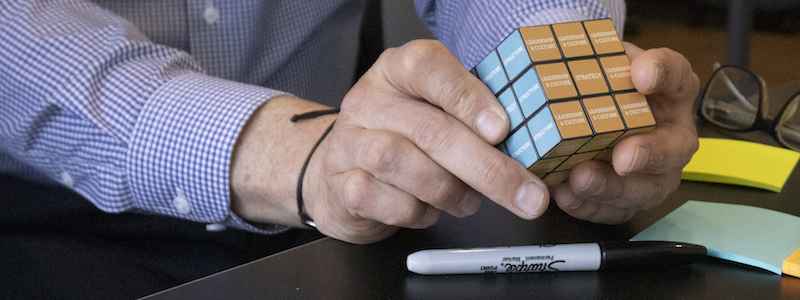We’ve all been there. You’re driving along, listening to music, then BAM – one of your tires hits a pothole that came seemingly out of nowhere. After, you notice that your steering wheel pulls a little to one side – no big deal, right? You assume the tire is a bit out of alignment, and you promise yourself that you’ll take it to the shop and get it fixed – eventually. What you might not realize is that the small misalignment of one tire could impact the fuel efficiency of your entire vehicle, and that single pothole could cost you a significant amount of money in gas.
What is Organizational Alignment?
Just like cars, organizations are very complex entities that need synergy among its processes, structures, systems, practices, metrics, talent, and company culture to function efficiently. To achieve optimal results, a leader must ensure all those elements align with the strategic goals of the organization.
Because these dimensions are all interrelated, aligning one organizational system can throw the others out of whack—a tug over here can result in an imbalance over there. Just like a misaligned tire can impact the entire vehicle, a small misalignment can adversely affect results across the entire organization. Another way to think about organizational alignment is by picturing a Rubik’s Cube. When one side is changed, the other five sides are also altered.
How Can Organizational Alignment Help You Reach Strategic Goals?
In our organization design work, we utilize a cube model—featured in the book Mastering the Cube—as an alignment tool that helps leaders more easily visualize their organizations’ various elements as interrelated parts of a whole, with each side representing a particular system. When all parts of an organization’s structure are aligned to strategy, organizations are poised to reach strategic goals.
Let’s look at how aligning your organizational systems can help support your strategic goals:
Side 1: Work Processes. The first system to consider when ensuring alignment within your organization is routines and processes, which are the daily tasks that create and deliver value. The activities that differentiate you as an organization and help you win should be prioritized.
Competitive work needs to be done as effectively as possible for a strong market position, whereas the non-competitive work necessary to support the organization should be done as efficiently as possible. This means that you should devote resources to strengthening the aspects of your organization that set it apart from the competition, while less-important functions, like bookkeeping or hiring, can be done more efficiently.
Side 2: Structure and Governance. Just as the work of an organization follows its strategy, the structure of an organization should follow naturally from the work. An organization’s structure will either enable or disable its potential to deliver value. A good structure will reflect your trade-offs and support the work that differentiates you from your competition.
Side 3: Information and Metrics. The information system of an organization includes the data itself as well as the technologies and tools for using, sharing, and storing it. For aligned, data-driven decisions to be made throughout the organization, information and metrics must be easily available, relevant, and provided to the right people at the right time.
Side 4: People and Rewards. The people and rewards system includes the recruitment, hiring, development, training, performance management, and succession processes of an organization. Aligning this area of the organization involves motivating employees, maximizing their potential, and ensuring that all systems are set up to support the strategic goals of the organization.
One example of this described in Mastering the Cube is Starbuck’s policy of extensive training and benefits for part-time baristas, even going so far as to create a special conflict-management technique for employees to use in stressful situations. Part of Starbucks’ strategy is to offer a friendly and welcoming environment, and so they ensure that their people and rewards are set up accordingly.
Side 5: Continuous Improvement. All parts of an organization must be agile enough to constantly adjust to changes in its market, industry, infrastructure, and people. Otherwise over time inefficiencies will start impacting systems and processes and disrupt alignment. A strong organization will have mechanisms in place to help identify and address these issues as they arise. The continuous improvement system of an organization includes the mechanisms, tools, and processes needed to review, renew, and realign organizational choices.
Side 6: Company Culture. While leaders can influence all other sides of the cube through direct decision making, culture is usually influenced rather than dictated. Through making aligned organizational choices, modeling actions consistent with the organization’s values, and sharing stories and examples that reinforce desired beliefs, leaders can shape company culture in ways that contribute to differentiation and value.
In short, what is organizational alignment? It’s a method of ensuring that every aspect of your organization supports your strategic goals, from work to rewards to culture. Just like the parts of a car, having one system out of alignment can impact the others and skew your expected results.
Certain elements in an organization drive other elements, so it is important to progress through this specific sequence as you align all the sides of your organization’s “cube”. Following the right progression will help facilitate complete organizational alignment, and keep your business running effectively, efficiently, and productively.





